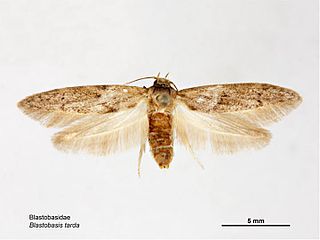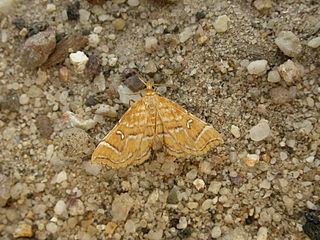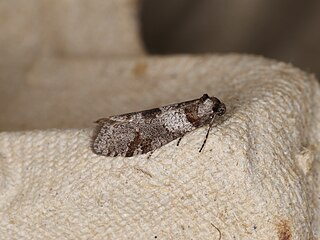
Aglossa pinguinalis, the large tabby or grease moth, is a moth in the subfamily Pyralinae. The species was first described by Carl Linnaeus in his 1758 10th edition of Systema Naturae. The dark-hued larvae feed on animal fats,

Barea codrella, the barea moth, is a moth of the family Oecophoridae. It is found in Australia, more specifically Tasmania, New South Wales and Victoria and South Australia. It is also an adventive species in New Zealand.

Sigillictystis insigillata is a species of moth of the family Geometridae. It is found in Australia, including Tasmania. This species has also been introduced to New Zealand.

Parienia is a genus of moths belonging to the subfamily Olethreutinae of the family Tortricidae. This genus was described by Edward Meyrick in 1881. It consists of only one species, Parienia mochlophorana, which is endemic to New Zealand.

Blastobasis tarda is a moth of the family Blastobasidae. It is found in Australia in Queensland and New South Wales.. It is an introduced species in North America, where it has been found in southern California. It has also been reported from France. There is a species in New Zealand that is very similar in appearance to B. tarda that has yet to be formally described.

Oinophila v-flava is a moth of the family Tineidae. It is widespread in temperate zones from Europe to South Africa, North America but also Hawaii. This species has also been recorded in New Zealand in 2001 and is regarded as having established itself in that country.
Porphyrosela hardenbergiella is a moth of the family Gracillariidae. First identified in a suburban garden in Epsom, Auckland, New Zealand in 1955 feeding on Hardenbergia, the species was likely introduced from Australia, although no members of the species have been found there.

Balanomis is a monotypic snout moth genus described by Edward Meyrick in 1887. Its single species, described in the same publication, Balanomis encyclia, is found in Australia, including New South Wales. This species has also been introduced to New Zealand.

Cosmopterix attenuatella is a moth of the family Cosmopterigidae described by Francis Walker in 1864. It is widely distributed in the tropics and subtropics of both the Old and New World, including the United States, Bermuda, the Cayman Islands, Virgin Islands, Dominica, Jamaica, Puerto Rico, Trinidad and Tobago, Costa Rica, Brazil, Ecuador, Peru, Argentina, the Canary Islands, Madeira, the Galápagos Islands, Cook Islands, Taiwan, Australia, New Zealand, Madagascar, Seychelles, Mauritius and Saint Helena.

Ephestiopsis oenobarella is a moth of the family Pyralidae. It is known from Australia. It has also been introduced into New Zealand.

Musotima ochropteralis is a moth of the family Crambidae. It was described by Achille Guenée in 1854 and is known from all of Australia. This species has been introduced to New Zealand.

The parsnip moth or parsnip webworm is a moth of the family Depressariidae. It is found in most of Europe, except Portugal and most of the Balkan Peninsula. This species has also been introduced into New Zealand.
Stictea ejectana, the guava bud moth, is a moth of the family Tortricidae. It was described by Francis Walker in 1863. It is found on Fiji, Samoa, the Marquesas Archipelago, Tahiti, Rapa Iti, the southern Mariana Islands, the Philippines and in New Caledonia, New Zealand and Australia.

Bactra optanias is a species of moth of the family Tortricidae first described by Edward Meyrick in 1911. It is found in Papua New Guinea, Australia, New Zealand, Java, Tahiti, Sri Lanka, New Caledonia, the Caroline Islands, the southern Mariana Islands, Rapa Iti and Micronesia.
Platyedra subcinerea, the mallow groundling or cotton stem moth, is a moth of the family Gelechiidae. It is found in most of Europe. It is an in introduced species in North America, where it has been recorded from New England and California, and has also been introduced to New Zealand. The habitat consists of wet meadows, marshes and gardens.

Lepidoscia heliochares is a moth of the Psychidae family first described by Edward Meyrick in 1893. This species is native to Australia but has been found in New Zealand since 1974.

Lepidoscia protorna is a moth of the Psychidae family first described by Edward Meyrick in 1893. This species is native to Australia but has been found in New Zealand since 1978.

Strepsicrates sideritis is a species of moth in the family Tortricidae first described by Edward Meyrick in 1905. This species is endemic to New Zealand. The classification of this moth within the genus Strepsicrates is regarded as unsatisfactory and in need of revision. As such this species is currently also known as Strepsicrates (s.l.) sideritis.

Holocola emplasta is a species of moth in the family Tortricidae. This species is endemic to New Zealand and has been observed in the South Island. The larval hosts are species within the genus Coprosma. Adults of the species are on the wing during the New Zealand spring months.

Holocola parthenia is a species of moth in the family Tortricidae. It is endemic to New Zealand and has been observed in the North, South and the Chatham Islands. Larvae feed on Leucopogon fasciculatus. This moth is one of the earliest to emerge in the New Zealand spring with adults being observed from August to December. Adults are attracted to light.
















